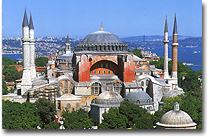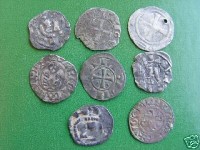|
|
|
A Great Empire; The Byzantines
In the year 395, when the Roman emperor Theodosum I divided the empire and placed his son Arcadius at the head of the Eastern side and his other son Honorius on the throne of the Western side, he could not have known what kinds of effects this action was to have on the future. The Western Roman Empire, with Honorius at its head, was to have a short life. The Eastem Roman Empire, however, was to last almost one thousand years until it was finally put to an end by the Ottoman Empire Mehmet II when he conquered the city of Istanbul in 1453.
|
| |
Sixty five years later, however, the name of the city was changed to Constantinople in honor of its founder, Constantine. Even though this radical change was made in the concept of the empire, the Byzantines always referred to themselves during their one thousand year long history as the Roman Empire and their nation as the Nation of Rome. After the collapse of the empire, however, historians began to refer to this empire as the "Byzantine" Empire and so it is remembered today. This empire began in 330 and lasted until 1453, for 1123 years. A struggle between Moslems and Christians began to arise in the Middle Ages. Those warriors known as the Crusaders were the most concrete example of the struggle between these two major religious beliefs. |
|
|
| |
The most important change made when the Roman Empire evolved into the Byzantine was the change in religion. While Rome was a polytheistic society, the Byzantines accepted monotheism as the basis for their religious belief. The second greatest change that occurred in the empire was the change in language. The Roman Empire used a number of languages, but Latin was the official language of its government. Latin was used increasingly less after the founding of Byzantium and Greek began to take its place as the official language. Naturally, this change also brought with it major political changes.
|
 Hagia Sophia
Hagia Sophia |
| |
Dark Ages
The most powerful periods of the Byzantium Empire were years that were stagnant in terms of advancement of thought, but were highly active in terms of religion. It should not be forgotten, however, that it was this highly detailed embroidery of the Middle Ages that was to pave the way for the Renaissance. The struggle between two very great religions, Islam and Christianity, was to lead to the development of Islamic civilization on the one hand, and Byzantine civilization on the other. Byzantine art was a synthesis of the Christian art forms of the Middle Ages, their own art forms which had existed in the pre-Christian early period, and all of the arts that had been gleaned from the territories and countries which were under the rule of the Empire. Elements of Anatolian, Iranian, Italian, Egyptian, Syrian, Balkan, and North African cultural forms could all be found within this aggregate. The principal element within this synthesis was, however, the Anatolian.
Byzantine arts in their earliest periods were closely related to the changes which had occurred in the Roman Empire. Because the Byzantine Empire did not have its own unique beginning as a civilization, this early transitional period is referred to as the period of "Early Christian Art." Following this early period, the art forms of the Byzantine can be classified as having three distinct stages. The first stage is called the "Early" or the "First Byzantine" stage. This period began in the fifth century and continued on until 726. Byzantine art produced its first original and important pieces during this period. This was the period of time in which the Emperor Justine played such an important role and this period is termed the "Justinian Period." Certain internal struggles began to appear near the close of the seventh century. People began to rise up against the restraints placed upon them by the church and the monasteries. The period of Iconoclasm began at the beginning of the 8th century as a reaction to church pressures. As this reaction grew, many religious paintings were destroyed and such paintings were forbidden. Many monasteries were closed and the nuns and priests of these orders were forced into the street to live as common citizens. Painting became a secular art as non-religious subjects were chosen. The Middle Stage of Byzantine art began in 842 when the church regained much of its power. This period lasted for almost four hundred years. Byzantine art matured during this period and developed its own unique characteristics. It also assimilated elements of Islamic civilization.
The rulers of this period came from the line of the Macedonians and the Kommenos. While the Seljuk Empire was being established in Anatolia, the Byzantines were in the midst of an internal power struggle. Another period of Crusades had again begun. As a result of all these various pressures, much of the Empire was divided into small principalities, and in its last century there was almost no attention paid to the arts. New art forms began to make their appearance in the Mora and Epiros Despots who had broken off from the Empire and in the government of Trabzon.
Generally speaking , Byzantine art forms are composed of two main elements. lts primary characteristic is that fmds its source in religion. The second chief characteristic is that it developed as an aristocratic art form among the royal circle.
There are very unique examples of Byzantine architecture found in its capitol city of Constantinople and in other cities in Anatolia. The advancement of sculpture went hand-in-hand with the advancement of architecture. Besides architecture and sculpture, there are many excellent examples of painting, handicrafts, gold enameled work, and pottery which were left to us by the Byzantines.
|
 Byzantine silver coins
Byzantine silver coins |
|
|


